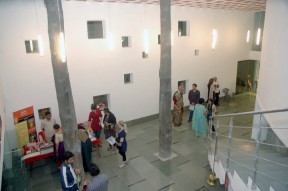 It is a calmer day than usual at Jagriti, Bangalore’s youngest theatre space. Squares of sunshine fall on the floor from the glass insets in the roof, two trees shoot from the floor to the ceiling, prints of Rabindra Nath Tagore’s paintings watch you with eyes full of many deeply lived lifetimes from a softly curving wall. There is a Yusuf Arakkal mural that seems to be made of metal and air and the human spirit in flight. A metal bell is suspended in the courtyard and a tug and chime later, there is Jagdish Raja, perpetually genial and warm, making his way towards you.
It is a calmer day than usual at Jagriti, Bangalore’s youngest theatre space. Squares of sunshine fall on the floor from the glass insets in the roof, two trees shoot from the floor to the ceiling, prints of Rabindra Nath Tagore’s paintings watch you with eyes full of many deeply lived lifetimes from a softly curving wall. There is a Yusuf Arakkal mural that seems to be made of metal and air and the human spirit in flight. A metal bell is suspended in the courtyard and a tug and chime later, there is Jagdish Raja, perpetually genial and warm, making his way towards you.
 It is hard to sum up 30 years of committed theatre in banal sentences so this cannot be a question-and-answer session. We sit in an office with a sunbathed window overlooking luscious, distracting bunches of bougainvillea and he recollects the things that matter and the journey that brought him and wife Arundhati to their own theatre space and the culmination of a deeply longed-for dream.
It is hard to sum up 30 years of committed theatre in banal sentences so this cannot be a question-and-answer session. We sit in an office with a sunbathed window overlooking luscious, distracting bunches of bougainvillea and he recollects the things that matter and the journey that brought him and wife Arundhati to their own theatre space and the culmination of a deeply longed-for dream.
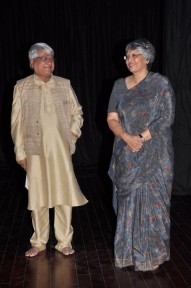 “We began with a play called Table Manners in 1977 with Bangalore Little Theatre(BLT) and BLT has been a nursery for virtually every theatre initiative in Bangalore. In 1982, Runa and I (Arundhati Raja) started Artistes’ Repertory Theatre (ART) and our first production was One Flew Over the Cuckoo’s Nest which was the first ever play to be staged at the Chowdiah Memorial Hall where till now only music concerts and dance recitals had taken place,” he shares.
“We began with a play called Table Manners in 1977 with Bangalore Little Theatre(BLT) and BLT has been a nursery for virtually every theatre initiative in Bangalore. In 1982, Runa and I (Arundhati Raja) started Artistes’ Repertory Theatre (ART) and our first production was One Flew Over the Cuckoo’s Nest which was the first ever play to be staged at the Chowdiah Memorial Hall where till now only music concerts and dance recitals had taken place,” he shares.
The couple never needed to look back after that. There was also Who’s Afraid Of Virginia Woolf that won ART the first place at a theatre festival hosted by a newspaper followed by many milestones through the years. Says Raja, “We are perhaps the most consistent theatre group in India though there are many now who are doing prolific work.”
 Apart from the body of work amassed however, what the Rajas have earned most importantly is a sense of fellowship and camaraderie that brought friends like Arundhati Nag, Sanjana Kapoor, Yusuf Arakkal and scores of rangkarmis and well-wishers to the opening of Jagriti in January. Raja recalls with a twinkle in the eye,”Sanjana (Kapoor) said that even though we had birthed Jagriti, it was upto her and other theatre professionals to nurture the baby and Aru (Arundhati Nag) brought people to her feet when she said that we were fools because we chose to gift this theatre space to others when we could have negotiated for a few more flats for ourselves.”
Apart from the body of work amassed however, what the Rajas have earned most importantly is a sense of fellowship and camaraderie that brought friends like Arundhati Nag, Sanjana Kapoor, Yusuf Arakkal and scores of rangkarmis and well-wishers to the opening of Jagriti in January. Raja recalls with a twinkle in the eye,”Sanjana (Kapoor) said that even though we had birthed Jagriti, it was upto her and other theatre professionals to nurture the baby and Aru (Arundhati Nag) brought people to her feet when she said that we were fools because we chose to gift this theatre space to others when we could have negotiated for a few more flats for ourselves.”
Yes, the origin of Jagriti must be recounted here. The Rajas had a three acre farm which a builder bought from them and instead of asking for a massive chunk of real estate, the two asked that a theatre space be built within the housing complex. They do have homes in the complex now but not as many as they would have had if the intention had been to only make money. It was a long journey though. The construction began in March, 2004 and fruitfully ended only in January 2011. And today Jagriti is a space where creative legacies are built.
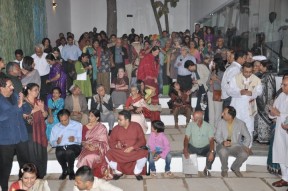 It is incredibly exciting to think that young children in the apartment complex where the Rajas live today, are just a courtyard away from theatrical performances, film screenings, talks and inputs that will shape their minds and maybe change the way they look at life forever. “We have no intention of packing up now,” says Raja and adds, “now that we have this. And we are blessed, so blessed that we have a team that believes in this just as much as we do.” He points at a light-and-sound assistant who drops in surreptitiously even on a day off.
It is incredibly exciting to think that young children in the apartment complex where the Rajas live today, are just a courtyard away from theatrical performances, film screenings, talks and inputs that will shape their minds and maybe change the way they look at life forever. “We have no intention of packing up now,” says Raja and adds, “now that we have this. And we are blessed, so blessed that we have a team that believes in this just as much as we do.” He points at a light-and-sound assistant who drops in surreptitiously even on a day off.
Jagriti, shaped like the mind’s eye has much to offer both to the performers and the audience. There is a library packed with the entire Samuel French catalogue and other treasures. And ofcourse The Fat Chef’s Restaurant where we spent a lovely afternoon lingering over a blueberry cheesecake and a platter of delicately seasoned ratatouille.
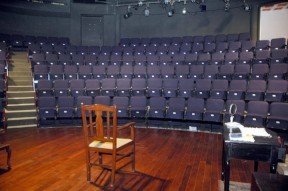 We walk to the auditorium, an elegant 200-seater space so acoustically refined that it needs no microphones though a stand-up comedian, says Raja, may need a mike to enunciate a whisper or a sound effect. The seats rise in almost symphonic synergy with the stage in sweeping arcs and Raja points at a catwalk that discreetly wraps itself around the theatre to enable quick and efficient light changes (there are 50 lights and two strobes). There are also sophisticated green rooms to allow actors to prepare themselves physically and mentally before they go on stage.
We walk to the auditorium, an elegant 200-seater space so acoustically refined that it needs no microphones though a stand-up comedian, says Raja, may need a mike to enunciate a whisper or a sound effect. The seats rise in almost symphonic synergy with the stage in sweeping arcs and Raja points at a catwalk that discreetly wraps itself around the theatre to enable quick and efficient light changes (there are 50 lights and two strobes). There are also sophisticated green rooms to allow actors to prepare themselves physically and mentally before they go on stage.
A sprawling terrace atop the theatre accommodates rehearsals and post event soirees. There is also the courtyard Lumbini(named after a school where generations of theatre performers have rehearsed for their shows) with graded grassy steps and a mini stage where talks, readings and spontaneous gatherings take place. “Do you know,” asks Raja, “that shoes were thrown at Ibsen when his plays were staged because what he wrote cut so close to the bone? Lumbiniis a space where the audience can interact with directors, writers and actors to understand their craft.” And because times have changed, only questions are likely to be flung at the writers. There is a silver oak here and a stately teak tree to shelter the audience and Raja hugs one of them to show his pride and joy in what has emerged from years of planning, planting dreams and detailing the space.
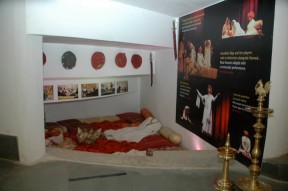 No too long ago, Jagriti paid a leisurely tribute to Tagore through drama, readings, music, films and discussions. Raja conjures up animatedly a mountain peak with his hands and says, “I have forever wanted to do something on the man.” And not define him as an insurmountable Everest but an immensely approachable human-being who just happened to be staggeringly gifted. After the tribute to Tagore, many people came up to Raja and Ranjon Ghoshal (who played a duel role in the play, Crisis of Civilisation: a Journey with Tagore) in speechless gratitude to thank them for bringing Tagore to life.
No too long ago, Jagriti paid a leisurely tribute to Tagore through drama, readings, music, films and discussions. Raja conjures up animatedly a mountain peak with his hands and says, “I have forever wanted to do something on the man.” And not define him as an insurmountable Everest but an immensely approachable human-being who just happened to be staggeringly gifted. After the tribute to Tagore, many people came up to Raja and Ranjon Ghoshal (who played a duel role in the play, Crisis of Civilisation: a Journey with Tagore) in speechless gratitude to thank them for bringing Tagore to life.
In October, the Rajas will initiate an unprecedented initiative and kick off a seven month long season of plays where seven national and international plays will be staged . Arundhati Raja chips in, “At some point, we want to set up the systems and pull away a little bit from the day to day functioning of the space.”
It has after all been a shared life that became focussed on theatre from the time the couple returned from UK in the 70s. And it is futile to ask Runa di (as she is known to her friends) what life would have been like if she had not met her husband and the two had not found in each other, a common passion for theatre. She says,”We will be celebrating our 40th anniversary shortly so it is hard to imagine any life other than the one I have lived with him. We have shared a lifetime together.” And what has kept them together for so long? “The fact that we still talk and find each other interesting. It is only when couples stop talking that relationships die,” she says.
What Jagdish and Arundhati Raja have built together is a rich personal and creative life and a family that spans across many continents. Jagdish Raja’s favourite Tagore quote is, “Yatra vishvam bhavati ek nidam (where the world makes its home in a single nest).”
Jagriti is that nest where the world indeed comes home to discover threads of music, art and culture that bind it together.
For more information, log onto





